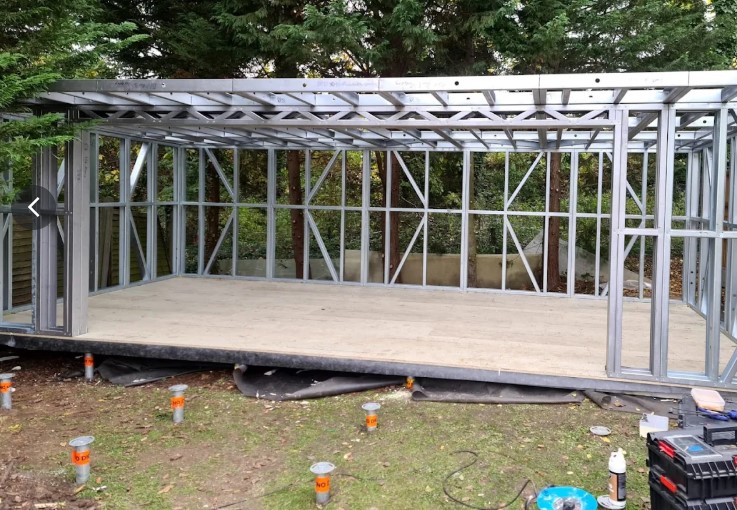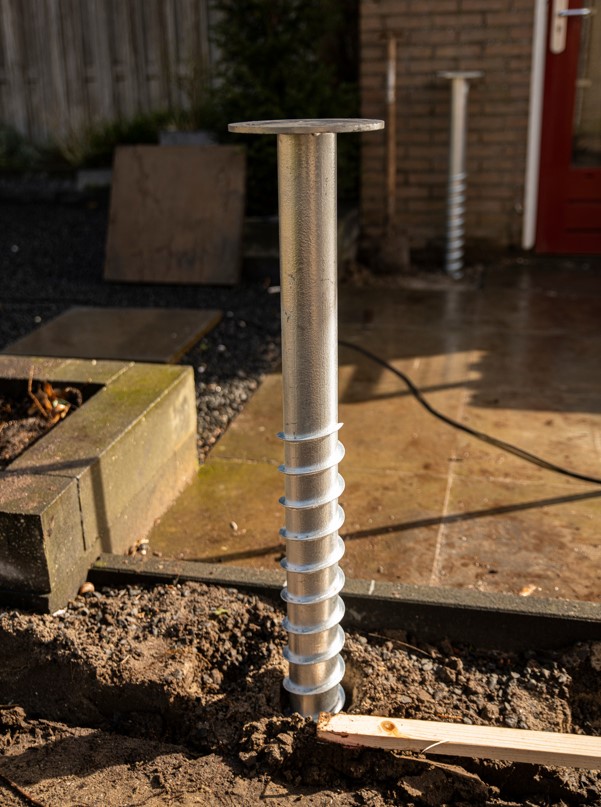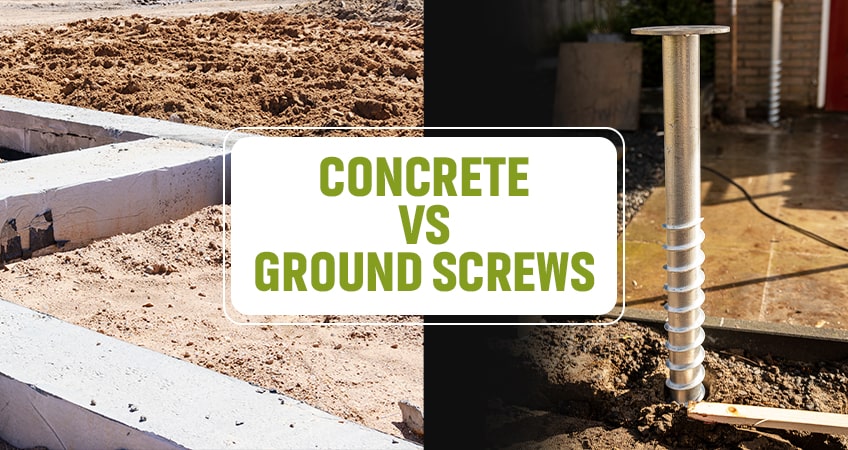Garden rooms have become increasingly popular as versatile spaces for work, relaxation, or hobbies. Whether used as a home office, a gym, or simply a tranquil retreat, a garden room offers endless possibilities.
However, constructing a garden room is about more than just the structure itself. The foundation plays a critical role in its stability and longevity, which is why choosing the right foundation is one of the most important decisions you’ll make during construction.
Two common foundation options for garden rooms are concrete and ground screws. Both have their unique advantages and drawbacks. This blog will provide an in-depth comparison of these two foundation methods, helping you make an informed decision about which is best for your garden room or next construction project.
Understanding concrete foundations

What are concrete foundations?
A concrete foundation involves pouring a mixture of cement, sand, and gravel to create a sturdy base for your garden room. These are typically either solid concrete pads or strips (often called strip foundations). Concrete is widely used in the construction industry due to its strength and ability to bear significant loads.
Installation process
The installation of a concrete foundation involves several steps:
- Site preparation: The area or construction site is cleared and levelled.
- Excavation: Soil is removed to create space for the concrete.
- Formwork: Wooden or metal frameworks are set up to contain the wet concrete.
- Pouring concrete and curing: Concrete is poured into the formwork and left to cure, which can take several days to weeks, depending on the weather.
Pros of building concrete foundations for construction projects
- Stability and load-bearing capacity: Concrete’s strength makes it ideal for larger or heavier garden rooms.
- Longevity and durability: Properly installed concrete building foundations can last decades, resisting weather and wear and maintaining its structural integrity.
Cons of building concrete foundations for construction projects
- Lengthy installation time: The curing process can take up to several weeks, delaying your project.
- Higher labour costs: Installation is labour-intensive, requiring skilled professionals.
- Environmental impact: Cement production generates high levels of carbon emissions, making concrete less eco-friendly.
- Susceptibility to weather conditions: Rain and cold weather can delay or disrupt the curing process.
Exploring ground screw foundations

What are ground screws?
Ground screws are large metal screws driven into the soil to act as foundation supports. They eliminate the need for excavation and concrete pouring, offering a more modern and efficient foundation solution.

Installation process
- Site survey: The area is assessed to determine the number and placement of screws.
- Screw installation: Ground screws are driven into the soil using specialist tools, reaching secure depths for stability.
- Structure attachment: Garden rooms are directly bolted to the screws.
Pros of ground screw foundations
- Faster construction process: Ground screws can often be installed in a single day.
- Reduced environmental impact: Minimal disruption to soil and no need for extensive excavation make ground screws a modern alternative with almost no waste material.
- Adaptability to various soil types and ground conditions: Ground screws provide a solution for sloped, rocky, or uneven terrain.
- Lower labour costs: Installation is faster and requires fewer workers.
- Weather conditions: Unlike concrete, ground screws can be installed in almost any weather.
Cons of ground screw foundations
- Limited suitability: Not ideal for very loose or sandy soils.
- Higher initial cost: The screws themselves can be more expensive than concrete materials.
Ground screws vs concrete: a detailed comparison
Installation time
Concrete foundations require extensive site preparation, excavation, and curing time, stretching the process over multiple days or weeks. Ground screws, on the other hand, can be installed in a matter of hours, making them the quicker option.
Cost analysis
Concrete foundations often involve higher labour costs due to the complex installation process, even though the materials are relatively inexpensive. Ground screws have a higher upfront cost but save on labour, offering competitive pricing overall.
Environmental impact
Concrete’s environmental toll is significant due to the carbon emissions from cement production. By contrast, ground screws offer a more sustainable option, thanks to their minimal soil disruption and reusability.
Durability and longevity
Concrete excels in durability, lasting decades with minimal maintenance. Ground screws are also long-lasting but may not match concrete’s lifespan in certain soil conditions. Regular inspections can help prolong their utility.
Suitability
Concrete is ideal for larger, permanent structures, while ground screws are versatile for garden rooms in varied environments, especially areas with uneven ground or tight spaces.
Real-world examples of both foundation options
- Concrete for added support: A client constructing a large garden gym might opt for concrete foundations to support the additional weight of heavy exercise equipment. The result will be a durable space suited for rigorous use.
- Ground screws in action: A garden home office can be built on a sloped yard using ground screws. The quick installation can enable the project to be completed in a fraction of the time and without the mess of excavation.
FAQ
Can ground screws handle heavy loads?
Yes, modern ground screws are designed to support significant weight, making them suitable for most garden rooms.
What if I have loose soil?
Specialised ground screws or soil testing can address this challenge.
Are traditional concrete foundations always necessary?
While durable, concrete isn’t always necessary for smaller or temporary garden rooms. Ground screws are a practical alternative in many cases.
How long do ground screws last?
Ground screws are made from durable, corrosion-resistant materials and can last for decades with proper installation and maintenance.
Can ground screws be removed or reused?
Yes, ground screws can often be removed and reused, making them an environmentally friendly choice compared to traditional concrete foundations.
Making the right choice for your garden room
When choosing between ground screws and concrete foundations, it’s essential to consider your specific needs. Here’s a simple step-by-step evaluation to guide your decision:
- Assess the soil type and terrain of your site.
- Determine the size and intended use of your garden room.
- Balance your budget with your urgency for completion.
- Prioritise your environmental values.
Ultimately, both ground screws and concrete foundations offer reliable support. The best choice depends on your unique circumstances and requirements.
Still not sure? Speak to one of our experts today!
A garden room is more than just an addition to your property; it’s a space where memories are made, work gets done, or hobbies thrive. It all starts with a solid foundation. If you’re unsure which foundation style suits your project, don’t leave it to guesswork. Contact Garden Rooms 365 today for a free consultation and expert recommendations tailored to your needs. With the right foundation, your dream garden room is within reach.



